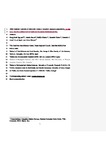Seasonal dynamics of native and invasive Halophila stipulacea populations—A case study from the northern Gulf of Aqaba and the eastern Mediterranean Sea
| dc.contributor.author | Manh Nguyen, H | |
| dc.contributor.author | Savva, I | |
| dc.contributor.author | Kleitou, Periklis | |
| dc.contributor.author | Kletou, D | |
| dc.contributor.author | Lima, FP | |
| dc.contributor.author | Sapir, Y | |
| dc.contributor.author | Winters, G | |
| dc.date.accessioned | 2020-01-21T19:01:20Z | |
| dc.date.available | 2020-01-21T19:01:20Z | |
| dc.date.issued | 2020-03 | |
| dc.identifier.issn | 0304-3770 | |
| dc.identifier.issn | 1879-1522 | |
| dc.identifier.other | 103205 | |
| dc.identifier.uri | http://hdl.handle.net/10026.1/15332 | |
| dc.description | No embargo required, pre-print. Full version requires 24 month embargo | |
| dc.description.abstract |
The tropical seagrass Halophila stipulacea is native to the Red Sea, Persian Gulf and the Indian Ocean. Following the opening of the Suez Canal, H. stipulacea became a Lessepsian immigrant, spreading to most of the eastern Mediterranean Sea. Its arrival in the Caribbean, where it has changed the local seagrass landscapes, has led to concerns about its potential effects on Mediterranean seagrass diversity. Surprisingly, morphological, growth, structural and demographic traits have never been quantitively compared between native and invasive populations of H. stipulacea. Aiming to deepen our understanding of the invasiveness potential of H. stipulacea, we recently established permanent monitoring transects at similar depths in both the native (Eilat, Israel) and invasive (Limassol, Cyprus) habitats. Samples were collected at both locations, four times during 2017 and were used for comparing morphological and growth traits (internode distance¸ leaf surface area) alongside structural and demographic traits (above and below ground biomass, percent cover, shoot density). Results show that above-ground biomass, shoot density and percent cover were higher year-round in Eilat than in Limassol, reaching a maximum in July (Eilat) and October (Limassol). Leaves in Eilat were larger than in Limassol but year-round, plants from Limassol had more apical shoots and larger internodes. This study used a standardized methodology to provide the first quantitive comparison between populations of native and invasive Halophila stipulacea and sheds light on the importance of long-term monitoring in both native (Red Sea) and invasive (Mediterranean and Caribbean Seas) regions. Results from our study are important for understanding the current population dynamics of H. stipulacea in both regions and could be used as baseline data for future assessments. | |
| dc.format.extent | 103205-103205 | |
| dc.language | en | |
| dc.language.iso | en | |
| dc.publisher | Elsevier BV | |
| dc.rights | Attribution-NonCommercial-NoDerivatives 4.0 International | |
| dc.rights | Attribution-NonCommercial-NoDerivatives 4.0 International | |
| dc.rights | Attribution-NonCommercial-NoDerivatives 4.0 International | |
| dc.rights | Attribution-NonCommercial-NoDerivatives 4.0 International | |
| dc.rights | Attribution-NonCommercial-NoDerivatives 4.0 International | |
| dc.rights | Attribution-NonCommercial-NoDerivatives 4.0 International | |
| dc.rights.uri | http://creativecommons.org/licenses/by-nc-nd/4.0/ | |
| dc.rights.uri | http://creativecommons.org/licenses/by-nc-nd/4.0/ | |
| dc.rights.uri | http://creativecommons.org/licenses/by-nc-nd/4.0/ | |
| dc.rights.uri | http://creativecommons.org/licenses/by-nc-nd/4.0/ | |
| dc.rights.uri | http://creativecommons.org/licenses/by-nc-nd/4.0/ | |
| dc.rights.uri | http://creativecommons.org/licenses/by-nc-nd/4.0/ | |
| dc.subject | Halophila stipulacea | |
| dc.subject | Seagrass monitoring | |
| dc.subject | Invasive species | |
| dc.subject | Seagrass cover | |
| dc.title | Seasonal dynamics of native and invasive Halophila stipulacea populations—A case study from the northern Gulf of Aqaba and the eastern Mediterranean Sea | |
| dc.type | journal-article | |
| dc.type | Journal Article | |
| plymouth.author-url | https://www.webofscience.com/api/gateway?GWVersion=2&SrcApp=PARTNER_APP&SrcAuth=LinksAMR&KeyUT=WOS:000518589600008&DestLinkType=FullRecord&DestApp=ALL_WOS&UsrCustomerID=11bb513d99f797142bcfeffcc58ea008 | |
| plymouth.volume | 162 | |
| plymouth.publication-status | Published | |
| plymouth.journal | Aquatic Botany | |
| dc.identifier.doi | 10.1016/j.aquabot.2020.103205 | |
| plymouth.organisational-group | /Plymouth | |
| plymouth.organisational-group | /Plymouth/Faculty of Science and Engineering | |
| plymouth.organisational-group | /Plymouth/Faculty of Science and Engineering/School of Biological and Marine Sciences | |
| plymouth.organisational-group | /Plymouth/Users by role | |
| plymouth.organisational-group | /Plymouth/Users by role/Academics | |
| dcterms.dateAccepted | 2020-01-13 | |
| dc.rights.embargodate | 2020-1-18 | |
| dc.identifier.eissn | 1879-1522 | |
| dc.rights.embargoperiod | Not known | |
| rioxxterms.versionofrecord | 10.1016/j.aquabot.2020.103205 | |
| rioxxterms.licenseref.uri | http://creativecommons.org/licenses/by-nc-nd/4.0/ | |
| rioxxterms.type | Journal Article/Review | |
| atmire.cua.enabled |



